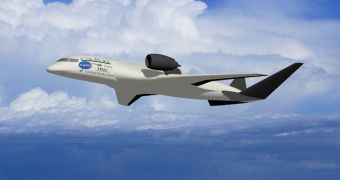Researchers at the NASA Ames Research Laboratory (ARC), in California, are currently testing a 1/11th-scale model of an advanced aircraft, which could form the basis of a new generation of passenger transport aircraft.
The Advanced Model for Extreme Lift and Improved Aeroacoustics (AMELIA) features a weird design, a crossover between a blended wing body and a conventional airplane with a standard tail.
Usually, BWB aircraft do not feature Tails. However, the current wind tunnel tests are showing that AMELIA appears to combine the two successfully. It currently comes in the form of an aluminum and steel model, weighing some 1,133 kilograms (2,500 pounds).
According to experts working on the project, the model combines three aircraft design features that engineers usually tend to avoid combining. In this case, they will enable the aircraft to take off and land over short distances.
“We know we can do short take-off and landing. We know we can do cruise efficient aircraft. And we know ways to reduce aircraft noise. The question was can we do all three at the same time?” Michael Rogers says of the challenges associated with designing AMELIA.
The expert holds an appointment as the technical lead at the ARC Efficient Aerodynamic Subproject. The issue with short landing and take-off distances, he explains, is that they require powerful engines, which are by definition very noisy.
The same objective could be achieved through modifying wing shapes, but this causes drag, and reduces cruise speed or fuel efficiency. The purpose of this project was to combine the three features, while eliminating most drawbacks.
During the wind tests, researchers are gathering information on whether or not AMELIA's current design is capable of answering these challenges. However, they explain that the true value of these tests is the data collected by multiple sensors on the aircraft model.
“What these tests really did for us was to generate data for an aircraft configuration that won't necessarily be flying, but will certainly look quite a bit different than what we're seeing now or have seen in the past,” ARC acoustics engineer Clif Horne explains.
For the next generation of aircraft, NASA wants increased fuel efficiency and noise reduction, especially over metropolitan areas. AMELIA could fly by 2025, and could come to the market in the form of a 100-passenger airliner.

 14 DAY TRIAL //
14 DAY TRIAL //